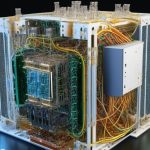
Table of Contents
INTRODUCTION
The concept of the internet started over 50 years ago when computers filled the entire room, today it is an ubiquitous information infrastructure, the initial prototype of what J. C. R. Licklider called the inter-galactic computer network (Wikipedia, 2018) has indeed becoming an inter-galactic network.
Its history is complex and involves many aspects – technological, organizational, and community; its influence reaches not only to the technical field of computer communications but throughout society.
The initial design of the internet was conceived by ARPA, was network that would be able to withstand a nuclear strike in event of nuclear strike.
ARPANET development began with two network nodes which were interconnected between the Network Measurement Center at the University of California, Los Angeles (UCLA) Henry Samueli School of Engineering and Applied Science directed by Leonard Kleinrock, and the NLS system at SRI International (SRI) by Douglas Engelbart in Menlo Park, California, on 29 October 1969 (Gregory Gromov, 1995)
According to B. Capenter, “Fortunately, nobody owns the Internet, there is no centralized control, and nobody can turn it off. Its evolution depends on rough consensus about technical proposals, and on running code. Engineering feed-back from real implementations is more important than any architectural principles.” (RFC 1958).
This presentation gives us quick overview of the present-day internet design architecture.
THE INTERNET ARCHITECTURE
The Internet architecture is by definition a meta-network, a constantly changing collection of thousands of individual networks intercommunicating with a common protocol.
It is based on a simple idea: ask all networks want to be part of carrying a single packet type, a specific format the IP protocol. In addition, this IP packet must carry an address defined with sufficient generality in order to identify each computer and terminals scattered throughout the world. This architecture is illustrated in Figure. 1

Figure 1.
To explain the design of the internet it is important to understand what makes up the internet architecture.
The internet architecture is made up of the following:
1. Communication Infrastructure
2. Protocols
3. Services
1. The Communication Infrastructure
The communications infrastructure of the Internet consists of its hardware components and a system of software layers that control various aspects of the architecture, these are divided into:
a. Routing and services tiers
b. Access
a. Routing and Service Tiers
Internet service providers establish the worldwide connectivity between individual networks at various levels of scope. End-users who only access the Internet when needed to perform a function or obtain information, represent the bottom of the routing hierarchy. At the top of the routing hierarchy are the tier 1 networks, large telecommunication companies that exchange traffic directly with each other via peering agreements. Tier 2 and lower level networks buy Internet transit from other providers to reach at least some parties on the global Internet, though they may also engage in peering. An ISP may use a single upstream provider for connectivity, or implement multihoming to achieve redundancy and load balancing. Internet exchange points are major traffic exchanges with physical connections to multiple ISPs. Large organizations, such as academic institutions, large enterprises, and governments, may perform the same function as ISPs, engaging in peering and purchasing transit on behalf of their internal networks.
Computers and routers use routing tables in their operating system to direct IP packets to the next-hop router or destination. Routing tables are maintained by manual configuration or automatically by routing protocols. End-nodes typically use a default route that points toward an ISP providing transit, while ISP routers use the Border Gateway Protocol to establish the most efficient routing across the complex connections of the global Internet.

Figure 2. (Wikipedia, 2018)
b. Access
Common methods of Internet access by users include dial-up with a computer modem via telephone circuits, broadband over coaxial cable, fiber optics or copper wires, Wi-Fi, satellite and cellular telephone technology (3G, 4G). The Internet may often be accessed from computers in libraries and Internet cafes. Internet access points exist in many public places such as airport halls and coffee shops. Various terms are used, such as public Internet kiosk, public access terminal, and Web payphone. Many hotels also have public terminals, though these are usually fee-based. These terminals are widely accessed for various usages, such as ticket booking, bank deposit, or online payment. Wi-Fi provides wireless access to the Internet via local computer networks. Hotspots providing such access include Wi-Fi cafes, where users need to bring their own wireless devices such as a laptop or PDA.

Figure 3.
2. Protocols
While the hardware components in the Internet infrastructure can often be used to support other software systems, it is the design and the standardization process of the software that characterizes the Internet and provides the foundation for its scalability and success.
The Internet Protocol (IP) is the principal communications protocol in the Internet protocol suite for relaying packets across network boundaries. Its routing function enables internetworking, and essentially establishes the Internet.
IP has the task of delivering packets from the source host to the destination host solely based on the IP addresses in the packet headers. For this purpose, IP defines packet structures that encapsulate the data to be delivered. It also defines addressing methods that are used to label the datagram with source and destination information.
Historically, IP was the connectionless datagram service in the original Transmission Control Program introduced by Vint Cerf and Bob Kahn in 1974; the other being the connection-oriented Transmission Control Protocol (TCP). The Internet protocol suite is therefore often referred to as TCP/IP.
The first major version of IP, Internet Protocol Version 4 (IPv4), is the dominant protocol of the Internet. Its successor is Internet Protocol Version 6 (IPv6).

Figure 4. The TCP/IP protocol stack.
3. Services
The Internet carries many network services, most prominently mobile apps such as social media apps, the World Wide Web, electronic mail, multiplayer online games, Internet telephony, and file sharing services etc.
Many people use, erroneously, the terms Internet and World Wide Web, or just the Web, interchangeably, but the two terms are not synonymous. The World Wide Web is the primary application program that billions of people use on the Internet, and it has changed their lives immeasurably. However, the Internet provides many other services. The Web is a global set of documents, images and other resources, logically interrelated by hyperlinks and referenced with Uniform Resource Identifiers(URIs). URIs symbolically identify services, servers, and other databases, and the documents and resources that they can provide. Hypertext Transfer Protocol (HTTP) is the main access protocol of the World Wide Web. Web services also use HTTP to allow software systems to communicate in order to share and exchange business logic and data.
World Wide Web browser software, such as Microsoft’s Internet Explorer/Edge, Mozilla Firefox, Opera, Apple’s Safari, and Google Chrome, lets users navigate from one web page to another via hyperlinks embedded in the documents. These documents may also contain any combination of computer data, including graphics, sounds, text, video, multimedia and interactive content that runs while the user is interacting with the page. Client-side software can include animations, games, office applications and scientific demonstrations. Through keyword-driven Internet research using search engines like Yahoo!, Bing and Google, users worldwide have easy, instant access to a vast and diverse amount of online information. Compared to printed media, books, encyclopedias and traditional libraries, the World Wide Web has enabled the decentralization of information on a large scale.

Figure 5. Internet services
INTERNET GOVERNANCE
The Internet is a global network that comprises many voluntarily interconnected autonomous networks. It operates without a central governing body. The technical underpinning and standardization of the core protocols (IPv4 and IPv6) is an activity of the Internet Engineering Task Force (IETF), a non-profit organization of loosely affiliated international participants that anyone may associate with by contributing technical expertise. To maintain interoperability, the principal name spaces of the Internet are administered by the Internet Corporation for Assigned Names and Numbers (ICANN). ICANN is governed by an international board of directors drawn from across the Internet technical, business, academic, and other non-commercial communities. ICANN coordinates the assignment of unique identifiers for use on the Internet, including domain names, Internet Protocol (IP) addresses, application port numbers in the transport protocols, and many other parameters. Globally unified name spaces are essential for maintaining the global reach of the Internet. This role of ICANN distinguishes it as perhaps the only central coordinating body for the global Internet.
Regional Internet Registries (RIRs) allocate IP addresses:
African Network Information Center (AfriNIC) for Africa
American Registry for Internet Numbers (ARIN) for North America
Asia-Pacific Network Information Centre (APNIC) for Asia and the Pacific region
Latin American and Caribbean Internet Addresses Registry (LACNIC) for Latin America and the Caribbean region
Réseaux IP Européens – Network Coordination Centre (RIPE NCC) for Europe, the Middle East, and Central Asia.
Written by Onwuka Ugochukwu C.
References
Gregory Gromov (1995) “Roads and Crossroads of Internet History” Archived 27 January 2016 at
the Wayback Machine.
Ecomputer Notes (March, 2018). Internet Architecture Retrieved from
http://ecomputernotes.com/computernetworkingnotes/services-and-applications/internet-architecture
RFC 1958; B. Carpenter; Architectural Principles of the Internet; June, 1996.
Wikipedia (2018, February 14). Internet; Retrieved from
https://en.wikipedia.org/wiki/internet
“>



